Checking the thickness of the friction linings of the brake pads
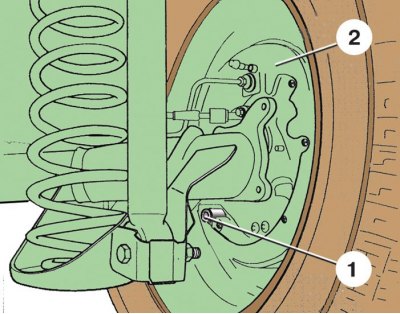
1 - plug; 2 - brake shield
Parts of the brake drum mechanism of the rear wheel
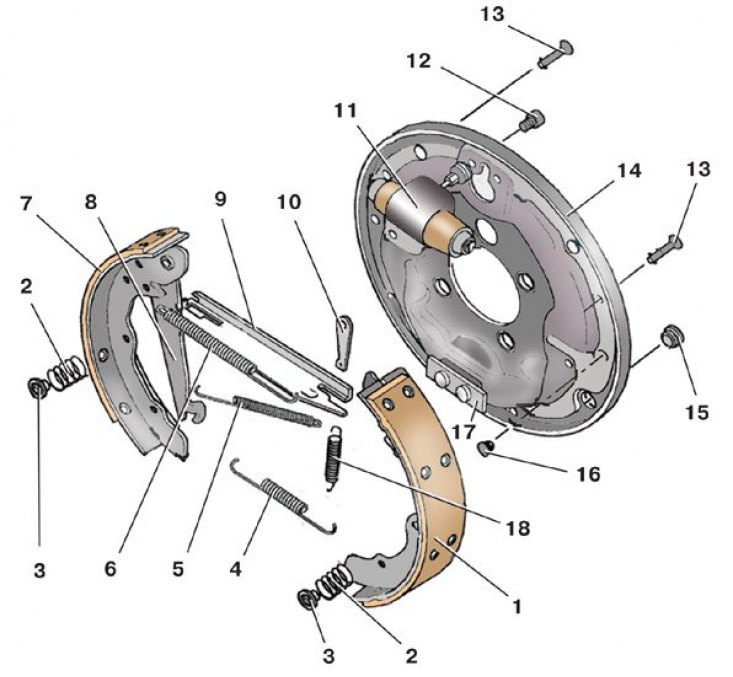
1 - front brake shoe; 2 - spring; 3 - cup; 4 – lower coupling spring; 5 - clamping spring of the spacer bar; 6 - upper coupling spring; 7– rear brake shoe; 8 – hand drive lever; 9 - spacer bar; 10 - adjusting wedge; 11 – wheel cylinder; 12 – a bolt of fastening of the wheel cylinder; 13 - rack; 14 - brake shield; 15 - plug; 16 - emphasis of the brake shoe; 17 - lower support pads; 18 – a pressing spring of an adjusting wedge
Dismantling the brake pads
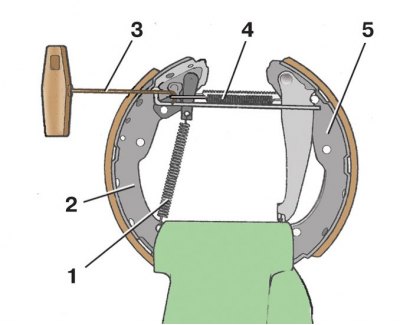
1 – a pressing spring of an adjusting wedge; 2 - front brake shoe; 3 - hook; 4 - upper coupling spring; 5 - rear brake shoe
Removing the spacer bar
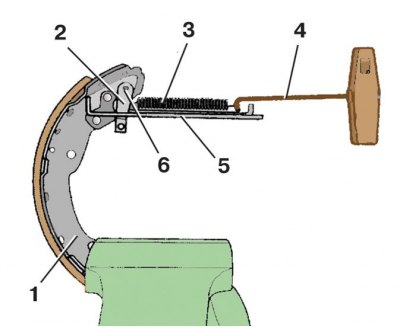
1 - front brake shoe; 2 - adjusting wedge; 3 - clamping spring of the spacer bar; 4 - hook; 5 - spacer bar; 6 - ledge on the adjusting wedge
Installing the spacer bar
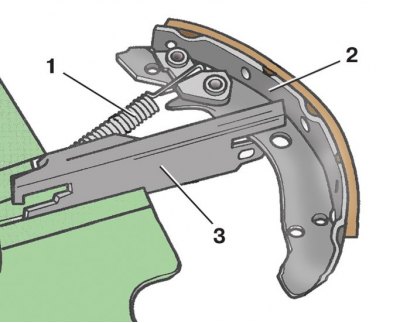
1 - clamping spring of the spacer bar; 2 - front brake shoe; 3 - spacer bar
Minimum allowable friction lining thickness (without foundation) - 1.5 mm.
You can check the thickness and condition of the brake pads without removing the wheel through the inspection hole on the inside of the brake shield 2 (see fig. Checking the thickness of the friction linings of the brake pads), closed with plug 1.
Replace brake pads in the following cases:
- the thickness of the friction lining is less than the permissible one;
- the surface of the pads is oiled;
- pads are loosely connected to the base;
- there are deep grooves and chips on the overlays.
Attention! Pad sets must be replaced on both sides of the front suspension at the same time.
Attention! Do not use gasoline, diesel fuel or any other mineral solvents to clean the brakes.
1. Remove the brake drum (see subsection 9.7.2).
2. Press with pliers on cup 3 (see fig. Parts of the brake drum mechanism of the rear wheel), rotate it 90° (holding the post 13 on the back side of the brake shield 14), remove the cup 3 together with the spring 2 and take out the stand 13 from the reverse side of the brake shield. In the same way, remove the rack with the spring and the cup of the other shoe.
3. Using a screwdriver, remove the lower toes of the base of blocks 1 and 7 from the lower support 17.
4. Disconnect the bottom coupling spring 4 from the shoes.
5. Disconnect the parking brake cable from the lever 8 of the hand drive.
6. Carefully spreading blocks 1 and 7, remove them from the brake shield 14.
7. Clamp the brake pads in a vise.
8. Remove compression spring 1 (see fig. Dismantling the brake pads) adjusting wedge.
9. Remove the upper coupling spring 4 and remove the rear shoe 5 from the vise (with hand lever).
10. Remove compression spring 3 (see fig. Removing the spacer bar) spacer bar.
11. Remove spacer bar 5 with adjusting wedge 2.
12. Before installing new pads, bring the pistons of the wheel cylinder 11 (see fig. Parts of the brake drum mechanism of the rear wheel), by pushing them with two mounts.
13. Lubricate the contact points of the spacer bar with the pad with solid grease G 000 650 or other grease.
14. Connect compression spring 1 (see fig. Installing the spacer bar) spacer bar to the front shoe 2 and install spacer bar 3 on the shoe.
15. Attach the other end of the compression spring to the spacer bar.
16. Install the adjusting wedge by guiding the lug 6 (see fig. Removing the spacer bar) wedge out.
17. Insert the rear brake shoe into the slot of the spacer bar, having previously lubricated the contact points of the bar with the shoe with solid grease G 000 650 or other grease.
18. Install the upper return spring 6 (see fig. Parts of the brake drum mechanism of the rear wheel).
19. Install the compression spring 18 of the adjusting wedge.
20. Carefully install the brake pads on the brake shield.
21. Connect the parking brake cable to the lever 8 of the hand drive.
22. Lubricate the contact points of the lower return spring and shoes with solid grease G 000 650 or other grease.
23. Install the lower coupling spring 4 and insert the ends of the blocks into the lower support 17.
24. Install racks 13 on the reverse side of the brake shield, put springs 2 on them and fix them with cups 3 (turning them 90°).
25. Install the brake drum.
26. Press the brake pedal several times to bring the pistons into position.
27. Adjust the parking brake and install the wheel. Bolts of fastening of a wheel finally tighten only on the car standing on the earth.
The tightening torque of the wheel bolts is 120 Nm.
